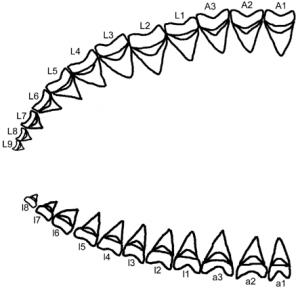Guest Author: Jack Cooper, MSc
UoB Graduate / PhD Student, University of Swansea
You might be surprised to hear that the scientific consensus on Megalodon’s maximum body size has varied over the last few decades. A lot of this has to do with how we estimate the shark’s total length (TL). This is a hard thing to do considering that palaeontologists mostly have only its fossil teeth to go off of [1]. Like all modern sharks, Megalodon’s skeleton was made out of cartilage, which decomposes with the rest of the body after death and therefore has particularly poor preservation potential in the fossil record. However, calculating TL only takes a tooth and some fairly basic maths.

y=mx+c
In this equation, y is the shark’s TL (cm), m is the regression slope, x is the tooth height (mm) and c is an intercept that changes depending on the tooth’s jaw position. Mike Gottfried ran this equation in Megalodon using a total tooth height of 168 mm and estimated a shark reaching 1590 cm (15.9 m) long [2]. To date, this tooth is considered the largest available to palaeontologists and is found at the Field Museum of Natural History in Chicago, Illinois.
Kenshu Shimada took a slightly different approach. He took measurements of the tooth crown height (CH) (Fig. 1) from white shark jaw samples of known TL, noting the jaw position of each tooth (Fig. 2). From this, he ran a simple linear regression for each jaw position and obtained the linear relationships. With high correlation coefficients and clear statistical significance (p < 0.001), CH can therefore be used to predict TL in white sharks and by extension Megalodon [3]. Later studies would attempt to use crown width as well [4], but ultimately also found CH to be the best predictor of TL. Shimada then performed his regression on the same tooth Gottfried had used in his calculation (~125 mm CH) and found a marginally smaller TL of 14.45-15.11 m.
Although we’ve already discussed the great white shark’s more distant relation to Megalodon in Q1, it remains the best available ecological analogue as it is the only large macropredatory lamniform shark with serrated teeth still with us today. These linear relationships between CH and TL have since been extensively used on Megalodon teeth to calculate the TL of the shark those teeth belonged to [4-8].

So, to quick fire everything I’ve just discussed – Megalodon’s TL can be calculated using the CH of its teeth. These calculations, and the Pimiento and Balk study, have suggested average sizes of ~10-10.5 m, with maximum sizes apparently reaching 16-18 m. Just try to imagine an 18 m shark!
However, just last year, Kenshu Shimada returned to his previous work [3] to re-evaluate Megalodon body size [9]. Partially motivated by the release of 2018 film “The Meg”, which portrays sharks reaching 20-25 m TL, he reanalysed his old data on white sharks and compared his results to three of the largest anterior (A/a; see Fig. 2) teeth available. In this study, he discouraged the use of lateral teeth for his calculations as their exact position can be hard to identify. He therefore limited the teeth of his original data to the four anterior-most positions (A1; A2; a1; a2) and analysed them individually and together both as a linear regression and as a power function to identify which of these tooth positions had the best correlation to TL (highest correlation coefficient). Through this, upper anterior teeth were found to be considerably better predictors of TL than lower anterior teeth, with A2 teeth being particularly good (R2 = 0.982-0.986; 98.2-98.6% correlation). Applying his newfound linear regressions to the CH of the largest available anterior teeth, he obtained a TL of 14.2-15.3 m (Fig. 3). He does, however, note that a few larger teeth do exist in private collections. If those teeth were confirmed to be anterior, they might indicate even larger sharks, maybe even up to 18 m TL. This suggests that while larger sharks (> 15 m) were indeed possible, they were likely exceptionally rare.

References
- Hubbell G 1996. Using tooth structure to determine the evolutionary history of the white shark. In: Great White Sharks: the biology of Carcharodon carcharias (eds. Klimley AP & Ainley DG), 9-18, Academic Press, San Diego.
- Gottfried MD, Compagno LJV & Bowman SC 1996. Size and skeletal anatomy of the giant “megatooth” shark Carcharodon megalodon. In: Great White Sharks: the biology of Carcharodon carcharias (eds. Klimley AP & Ainley DG), 55–66, Academic Press, San Diego.
- Shimada K 2003. The relationship between the tooth size and total body length in the white shark. J. Fossil Res. 35, 28-33.
- Reolid M & Molina JM 2015. Record of Carcharocles megalodon in the Eastern Guadalquivir Basin (Upper Miocene, South Spain). Estud. Geol. 71, e032.
- Pimiento C, Ehret DJ, MacFadden BJ & Hubbell G 2010. Ancient nursery area for the extinct giant shark Megalodon from the Miocene of Panama. PLoS One 5, e10552.
- Pimiento C, González-Barba G, Ehret DJ, Hendy AJ, MacFadden BJ & Jaramillo C 2013. Sharks and rays (Chondrichthyes, Elasmobranchii) from the late Miocene Gatun formation of Panama. J. Paleontol. 87, 755-774.
- Pimiento C & Balk MA 2015. Body-size trends of the extinct giant shark Carcharocles megalodon: a deep-time perspective on marine apex predators. Paleobiology, 41, 479-490.
- Razak H & Kocsis L 2018. Late Miocene Otodus (Megaselachus) megalodon from Brunei Darussalam: Body length estimation and habitat reconstruction. Neues Jahrb. Geol. Paläontol. Abh. 288, 299–306.
- Shimada K 2019. The size of the megatooth shark, Otodus megalodon (Lamniformes: Otodontidae), revisited. Hist. Biol. 1–8.
Edited by Rhys Charles

